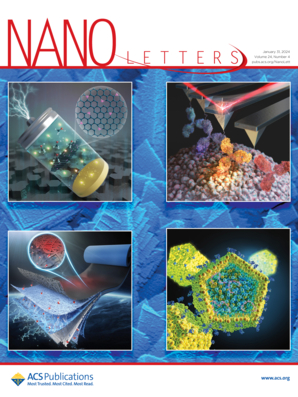Efficient and Stable Carbon-Based Hole-Transport-Layer-Free CsPbI2Br Solar Cells by Adding Trace Amounts of Yttrium Acetate into the Photoactive Layer.
IF 9.6
1区 材料科学
Q1 CHEMISTRY, MULTIDISCIPLINARY
引用次数: 0
Abstract
CsPbI2Br solar cells are a kind of important inorganic perovskite photovoltaic (PV) device that can serve as the top cells in a tandem configuration or semitransparent PV devices with balanced structural stability and light absorption. However, the issues relating to their power conversion efficiency (PCE) and long-term stability are still severely impeded by uncoordinated Pb2+ and migratable I-. To effectively passivate the uncoordinated Pb2+ and meanwhile anchor the migratable I-, herein, we propose a simple strategy by adding yttrium acetate (Y(Ac)3) in the photoactive layer. A leading PCE of 15.53%, together with the notably improved stability and reduced current-voltage hysteresis, indicates the effectiveness of this additive strategy, as demonstrated in the carbon-based hole-transport-layer (HTL)-free CsPbI2Br solar cells having a higher performance-to-cost ratio than their conventional counterparts because they abandon the usage of noble metal electrodes and the expensive organic HTLs that are also detrimental to the photoactive layer.在光活性层中加入微量醋酸钇制备高效稳定的碳基无空穴传输层CsPbI2Br太阳能电池。
CsPbI2Br太阳能电池是一种重要的无机钙钛矿光伏(PV)器件,可以作为串联结构的顶部电池或具有平衡结构稳定性和光吸收的半透明光伏器件。然而,与它们的功率转换效率(PCE)和长期稳定性相关的问题仍然受到不协调的Pb2+和可迁移的I-的严重阻碍。为了有效钝化未配位的Pb2+,同时锚定可迁移的I-,本文提出了一种简单的策略,即在光活性层中添加醋酸钇(Y(Ac)3)。领先的PCE为15.53%,稳定性显著提高,电流-电压滞后显著降低,表明了这种添加剂策略的有效性,正如在无碳基空穴传输层(HTL)的CsPbI2Br太阳能电池中所证明的那样,由于放弃了贵金属电极的使用和昂贵的有机HTL,它们也不利于光活性层,因此具有比传统同类更高的性能成本比。
本文章由计算机程序翻译,如有差异,请以英文原文为准。
求助全文
约1分钟内获得全文
求助全文
来源期刊

Nano Letters
工程技术-材料科学:综合
CiteScore
16.80
自引率
2.80%
发文量
1182
审稿时长
1.4 months
期刊介绍:
Nano Letters serves as a dynamic platform for promptly disseminating original results in fundamental, applied, and emerging research across all facets of nanoscience and nanotechnology. A pivotal criterion for inclusion within Nano Letters is the convergence of at least two different areas or disciplines, ensuring a rich interdisciplinary scope. The journal is dedicated to fostering exploration in diverse areas, including:
- Experimental and theoretical findings on physical, chemical, and biological phenomena at the nanoscale
- Synthesis, characterization, and processing of organic, inorganic, polymer, and hybrid nanomaterials through physical, chemical, and biological methodologies
- Modeling and simulation of synthetic, assembly, and interaction processes
- Realization of integrated nanostructures and nano-engineered devices exhibiting advanced performance
- Applications of nanoscale materials in living and environmental systems
Nano Letters is committed to advancing and showcasing groundbreaking research that intersects various domains, fostering innovation and collaboration in the ever-evolving field of nanoscience and nanotechnology.
 求助内容:
求助内容: 应助结果提醒方式:
应助结果提醒方式:


